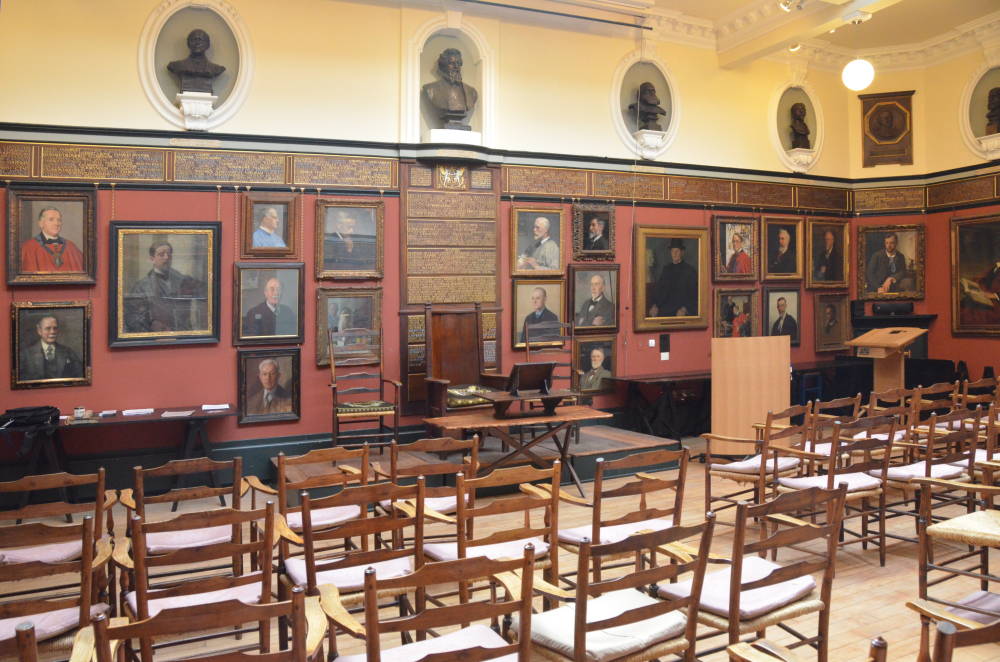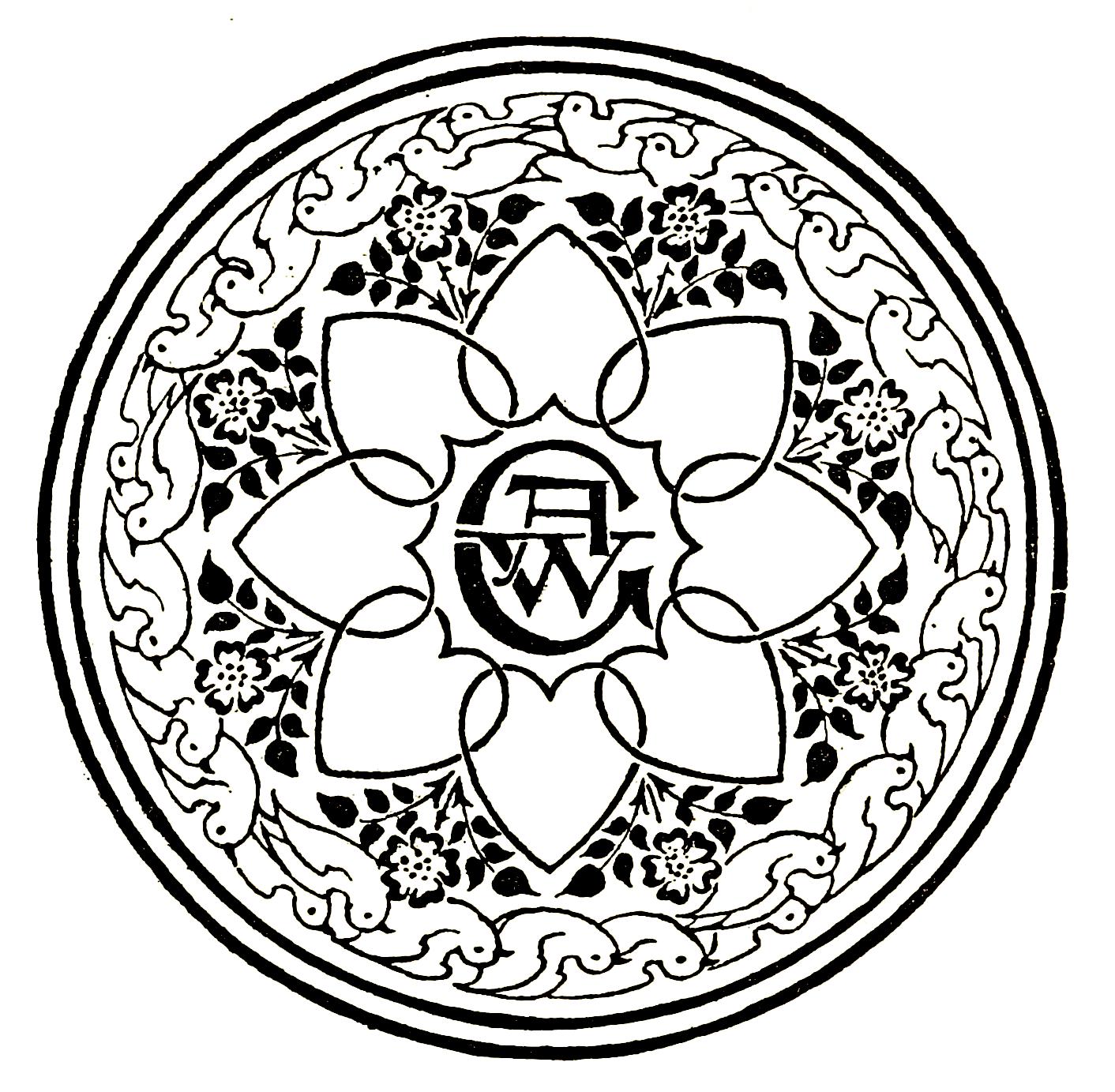

Background
In the last two decades of the nineteenth century, following in the footsteps of John Ruskin and William Morris, and Pugin before them, several bodies were intent on restoring the arts to what they believed to be its rightful place — the heart of the community. Taking part of its impetus from the rise of socialism, exemplified by the foundation of the Fabian Society, this drive towards communal creative endeavour matched and overlapped with currently growing concerns for social welfare and the democratisation of education, and had several discrete but related manifestations: see Arts and Crafts Chronology.
The first important manifestation was the Century Guild of Artists, founded in 1882 by the young architect Arthur Heygate Mackmurdo, with his former pupil and then partner Herbert Horne. They established a "loose partnership" of other craftsmen (Blakesley 55), including his friend Selwyn Image, and others, all notable in different fields, such as: the architectural decorator Clement Heaton, the sgraffito artist George Heywood Sumner, the sculptor Benjamin Creswick, and the ceramic artist, William de Morgan. What was important about the Century Guild was not so much the emphasis on the "essential unity of the arts" (not a new idea) but the "authoritative voice" of their journal (Vallence). This ran from 1884-94, for the first eight years as the Century Guild Hobby Horse, and then simply as the Hobby Horse. If Mackmurdo did not actually set the trend, he gave it a clear voice and therefore a higher profile.
The Founding of the Art Workers' Guild

Device featuring the Art Workers' Guild's initials. Source: Crane 14.
In the very year in which the Century Guild's journal started to appear, two other similarly motivated groups, the Fifteen, led by Lewis F. Day and Walter Crane, and the St George's Art Society, led by a band of Norman Shaw's protégés — including and most importantly W. R. Lethaby — linked up to make a more formal debating society. This was the Art Workers' Guild. At first, the Guild had a definite bias towards the fine arts and architecture, with painters in the majority, followed by architects, and just a few sculptors and other craftsmen: but in time it moved more towards the decorative arts, "promoting the creative marriage of architecture, art and design" (Blakesley 60).
The Art Workers' Guild and the Arts and Crafts Movement
Again, the Art Workers' Guild was a link in a larger chain. Before long the writer and bookbinder Thomas James Cobden-Sanderson (1840-1922) had coined the term "Arts and Crafts," suggesting it in 1887 as part of the title of the Arts and Crafts Exhibition Society. This was duly founded in 1888 (see Blakesley 53), and the two organisations had many members in common. Cobden-Sanderson's useful essay on the Arts and Crafts movement sums up the objectives of both the Exhibition Society and the Art Workers' Guild:
all new work was to be conceived of as convergent upon one end, the dignity and sweetness of life, and the workman — artist or craftsman — was to derive therefrom his measure of happiness & delight. And that work, which for the world had lost all association with human initiative & solicitude, was to be made to resume that intimate relation, and the workman himself to be recalled into the assembly of those who are consciously striving to the acknowledged end. The workmen contributing to the creation of a work were to be thenceforward named its author, and to have their names inscribed upon the great roll of the world's ever visible record. (np)
Not only were individual craftsmen to be encouraged and "acknowledged," but their successors were to be nurtured. Thus "the Arts and Crafts Exhibition Society had a strong educational drive, organising lectures and demonstrations to coincide with its exhibitions, which were also accompanied by catalogues containing essays on the decorative arts" (Meacock).
The Exhibition Society had, in fact, taken over from the Guild the function of exhibiting. But Guild members too were "prominent in the reform of art education.... they emphasised 'learning by doing,' and challenged the class distinction between 'gentleman' designers and tradesmen" ("History"). In such ways the Guild retained its own identity, and has fairly been described as "the conscientious core of the Arts and Crafts Movement" (Crowley 134). Unlike C. R. Ashbee's Guild of Handicrafts, founded in 1888, it continued without break and flourishes to this day. — Jacqueline Banerjee
Selected Painted Commemorative Portraits of Masters of the Guild
- Gilbert Bayes (1925) by G. N. Meredith Frampton
- Robert Anning Bell (self-portrait, 1921)
- Sir George Frampton, R.A (1902) by William Strang
- Graham Jackson, B.I., R. A. (1896) by Solomon J. Solomon
- F. W. Pomeroy (1908) by Robert Anning Bell
Selected Sculpted Commemorative Portraits of Masters of the Guild
- C. R. Ashbee (1929) by Allan G. Wyon
- Walter Crane (1889) by George Blackall-Simonds
- Selwyn Image (1900) by William Silver Frith
- W. R. Lethaby (1911) by Gilbert Bayes
- William Morris (1892) by Conrad Dressler
- William Strang (1907) by Sir George Frampton
- Francis W. Troup (1923) by Gilbert Bayes
- Thomas Stirling Lee (1898) by Arthur George Walker
- Heywood Sumner (1894) by Henry Alfred Pegram
- Charles Harrison Townsend (1903) by Francis Derwent Wood
Related Material
Bibliography
Blakesley, Rosalind P. The Arts and Crafts Movement. Pbk ed. London and New York: Phaidon, 2009 (review by Antoine Capet).
Cobden-Sanderson, Thomas James. The Arts and Crafts Movement. London: Hammersmith Publishing Society, 1905. Internet Archive. Web. 21 October 2013.)
Crane, Walter. Beauty's Awakening: A Masque of Winter and of Spring. London: The Studio, 1899. Internet Archive. Contributed by University of California Libraries. Web. 29 August 2020.
Crawley, David. Introduction to Victorian Style. Royston, Herts.: Eagle Editions, 1998.
"History." The Art Workers' Guild. Web. 21 October 2013.
Meacock, Joanna. Introductory Essay: "The Exhibition Society." Part of a University of Glasgow project on "Exhibition Culture in London: 1878-1908." Web. 21 October 2013.
Vallance, Aymer. "Mr. Arthur H. Mackmurdo and the Century Guild." The Studio. Vos. 14-16 (1899), 16: 183-92. Internet Archive. Web. 21 October 2013. [Full text on the Victorian Web.]
Last modified 13 April 2013